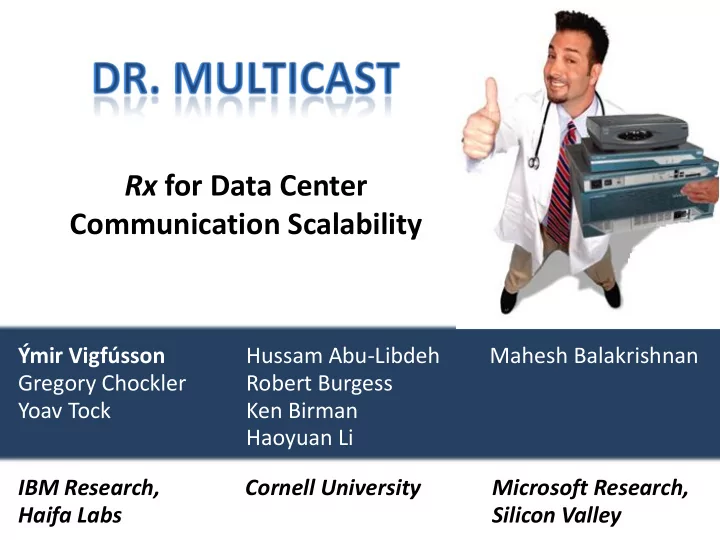

Rx for Data Center Communication Scalability Ýmir Vigfússon Hussam Abu-Libdeh Mahesh Balakrishnan Gregory Chockler Robert Burgess Yoav Tock Ken Birman Haoyuan Li IBM Research, Cornell University Microsoft Research, Haifa Labs Silicon Valley
IP Multicast in Data Centers Useful – IPMC is fast, and widely supported – Multicast and pub/sub often used implicitly – Lots of redundant traffic in data centers [Anand et al. SIGMETRICS ’09] Rarely used – IP Multicast has scalability problems!
IP Multicast in Data Centers • Switching hierarchies
IP Multicast in Data Centers • Switches have limited state space Switch model (10Gbps) Group capacity Alcatel-Lucent OmniSwitch OS6850-4 260 Cisco Catalyst 3750E-48PD-EF 1,000 D-Link DGS-3650 864 Dell PowerConnect 6248P 69 Extreme Summit X450a-48t 792 Foundry FastIron Edge X 448+2XG 511 HP ProCurve 3500yl 1,499
IP Multicast in Data Centers
IP Multicast in Data Centers • NICs also have limited state space E.g. 16 exact addresses 512-bit Bloom filter
IP Multicast in Data Centers
IP Multicast in Data Centers • Kernel has to filter out unwanted packets!
IP Multicast in Data Centers • Packet loss triggers further problems – Reliability layer may aggravate loss – Major companies have suffered multicast storms IPMC has dangerous scalability issues
Dr. Multicast Key ideas • Treat IPMC groups as a scarce resource – Limit the number of physical IPMC groups – Translate logical IPMC groups into either physical IPMC groups or multicast by iterated unicast. • Merge similar groups together
Dr. Multicast • Transparent: Standard IPMC interface to user, standard IGMP interface to network. • Robust: Distributed, fault-tolerant service. • Optimizes resource use: Merges similar multicast groups together. • Scalable in number of groups: Limits number of physical IPMC groups.
Dr. Multicast • Library maps logical IPMC to physical IPMC or iterated unicast • Transparent to the application – IPMC calls intercepted and modified • Transparent to the network – Ordinary IPMC/IGMP traffic
Dr. Multicast • Transparent: Standard IPMC interface to user, standard IGMP interface to network. • Robust: Distributed, fault-tolerant service. • Optimizes resource use: Merges similar multicast groups together. • Scalable in number of groups: Limits number of physical IPMC groups.
Dr. Multicast • Per-node agent maintains global group membership and mapping – Library consults local agent • Leader agent periodically computes new mapping (see later). • State reconciled via gossip
Library Layer Overhead • Experiment measuring sends/sec at one sender • Sending to r addresses realizes roughly 1/ r ops/sec • Insignificant overhead when mapping logical IPMC group to physical IPMC group.
Network Overhead and Robustness • Experiment on 90 Emulab nodes Half of the nodes die Nodes introduced 10 at a time. Average traffic received per-node. Total network traffic grows linearly. Robust to major correlated failure
Dr. Multicast • Transparent: Standard IPMC interface to user, standard IGMP interface to network. • Robust: Distributed, fault-tolerant service. • Optimizes resource use: Merges similar multicast groups together. • Scalable in number of groups: Limits number of physical IPMC groups.
Optimization questions Multicast BLACK Users Groups Users Groups
Optimization Questions Assign IPMC and unicast addresses s.t. Min. receiver filtering Min. network traffic Min. # IPMC addresses … yet deliver all messages to interested parties
Optimization Questions Assign IPMC and unicast addresses s.t. receiver filtering ( 1 ) network traffic # IPMC addresses (hard) M • Knob to control relative costs of CPU filtering and of duplicate traffic. • Both and are part of administrative policy. M
MCMD Heuristic Groups in `user- interest’ space G RAD S TUDENTS F REE F OOD (1,1,1,1,1,0,1,0,1,0,1,1) (0,1,1,1,1,1,1,0,0,1,1,1)
MCMD Heuristic Groups in `user- interest’ space Grow M meta-groups around the groups greedily while cost decreases
MCMD Heuristic Groups in `user- interest’ space Grow M meta-groups around the groups greedily while cost decreases
MCMD Heuristic Unicast Unicast Groups in `user- interest’ space 224.1.2.4 224.1.2.5 224.1.2.3
Data sets/models • Social: – Yahoo! Groups Users Groups – Amazon Recommendations – Wikipedia Edits – LiveJournal Communities – Mutual Interest Model
MCMD Heuristic • Total cost on samples of 1000 logical groups. – Costs drop exponentially with more IPMC addresses
Data sets/models • Social: – Yahoo! Groups Users Groups – Amazon Recommendations – Wikipedia Edits – LiveJournal Communities – Mutual Interest Model • Systems: – IBM Websphere
MCMD Heuristic • Total cost on IBM Websphere data set (simulation) – Negligible costs when using only 4 IPMC addresses
Dr. Multicast • Transparent: Standard IPMC interface to user, standard IGMP interface to network. • Robust: Distributed, fault-tolerant service. • Optimizes resource use: Merges similar multicast groups together. • Scalable in number of groups: Limits number of physical IPMC groups.
Group Scalability • Experiment on Emulab with 1 receiver, 9 senders • MCMD prevents ill-effects when the # of groups scales up
Dr. Multicast IPMC is useful, but has scalability problems Dr. Multicast treats IPMC groups as scarce and sensitive resources – Transparent, backward-compatible – Scalable in the number of groups – Robust against failures – Optimizes resource use by merging similar groups • Enables safe and scalable use of multicast
Recommend
More recommend